Businesses in the mining and quarrying sector
Data extracted in February 2024
Planned article update: February 2025
Highlights
The mining and quarrying sector employed 378 000 people in the EU in 2021.
The mining and quarrying sector in the EU generated €101.9 billion of net turnover in 2021, an increase of almost 40 % compared with the previous year.
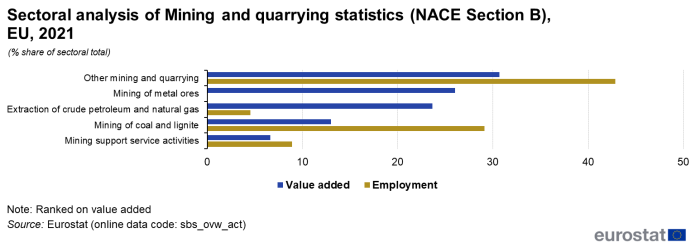
(% share of sectoral total)
Source: Eurostat (sbs_ovw_act)
This article presents an overview of statistics for European Union (EU) mining and quarrying, covering NACE Rev. 2 Section B. It belongs to a set of statistical articles on 'Business economy by sector'.
Full article
Structural profile
There were around 17 100 enterprises operating with mining and quarrying (Section B) as their main activity in the EU in 2021. Together they employed 378 000 persons, equivalent to 0.2 % of all persons employed in the business economy (Sections B to N and P to R, as well as Divisions S95 and S96), while they generated €37.4 billion of value added which was 0.4 % of the business economy total. Compared with 2020, the value added generated by mining and quarrying has increased by 38.2 %, while in terms of net turnover, the increase was 39.4 %, up to €101.9 billion.
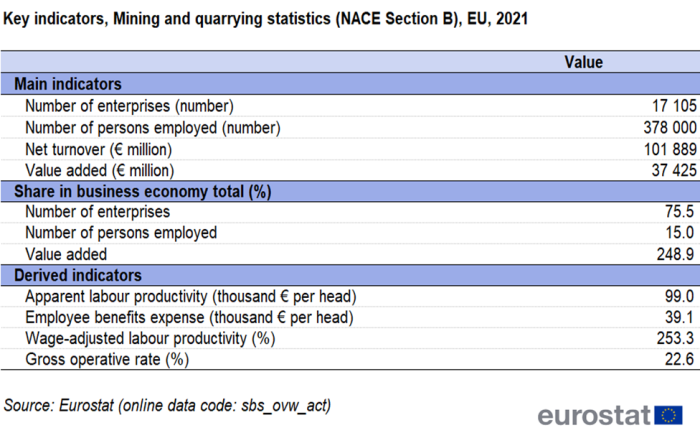
Source: Eurostat (sbs_ovw_act)
The mining and quarrying sector was the second smallest among the NACE sections within the business economy in terms of the number of enterprises, persons employed, and value added, as only the repair of computers and personal and household goods registered lower values in 2021. The wage-adjusted labour productivity ratio combines apparent labour productivity and average employee benefits expense (average personnel costs) and shows the extent to which value added per person employed covers average personnel costs per employee. Due to the high productivity and only slightly elevated average personnel costs, the EU’s mining and quarrying sector in 2021 had a wage-adjusted labour productivity ratio of 253.3 %, which was the fourth highest ratio across the NACE sections within the business economy.
Sectoral analysis
The two largest subsectors in terms of employment were the mining of coal and lignite (Division 05) and other mining and quarrying (Division 08), occupying 29.1 % of the mining and quarrying employment and 42.9 % respectively. In output terms, extraction of crude petroleum and natural gas (Division 06) accounted for 38.2 % of EU sectoral net turnover, while a further 32.3 % of sectoral turnover was derived from other mining and quarrying sector, and 16.3 % from mining of metal ores (Division 07). The mining of coal and lignite accounted for 7.2 % of the sector’s turnover, while mining support service activities (Division 09) had the lowest share of turnover (6.0 %) in 2021.

(% share of sectoral total)
Source: Eurostat (sbs_ovw_act)
As can be seen from Figure 1, the contribution of the various subsectors to the EU’s mining and quarrying total varied considerably depending on whether value added or employment was the basis for the analysis. The variation in the relative significance of the different subsectors was even more amplified for some of the derived indicators concerning personnel costs, labour productivity and profitability, as shown in Table 2b.
14 300 out of 17 100 enterprises within the EU’s mining and quarrying sector extracted materials that were non-metallic and not fossil fuels and were therefore classified in other mining and quarrying subsector. These represented around 84 % of enterprises active within the mining and quarrying sector in 2021 and have generated also the highest value added among the five subsectors, 11.4 billion— see Table 2a.

Source: Eurostat (sbs_ovw_act)
The high apparent labour productivity is present in the subsector of extraction of crude petroleum and natural gas, where apparent labour productivity reached €517nbsp;000 per person employed, the second highest NACE division within the whole of the business economy. On the other hand, the sector of mining of coal and lignite recorded an apparent labour productivity of €44 300 per person employed, below the business economy average (€60 200 per person employed). At the NACE division level, employee benefits per employee in the EU peaked at an average of €84 400 per employee for extraction of crude petroleum and natural gas in 2021, ahead of mining support service activities (€52 100 per employee), above the business economy average (€39 000 per employee). A somewhat lower level of average personnel costs was recorded for the mining of coal and lignite (€28 100 per employee).

Source: Eurostat (sbs_ovw_act)
Wage-adjusted labour productivity ratios for EU mining and quarrying NACE divisions in 2021 exceeded the business economy average (154.4 %), strongly pulled upwards by the extraction of crude petroleum and natural gas (613.0.3 %). This subsector achieved in 2021 the highest wage-adjusted labour productivity ratios among all of the NACE divisions within the whole of the business economy.
Country overview
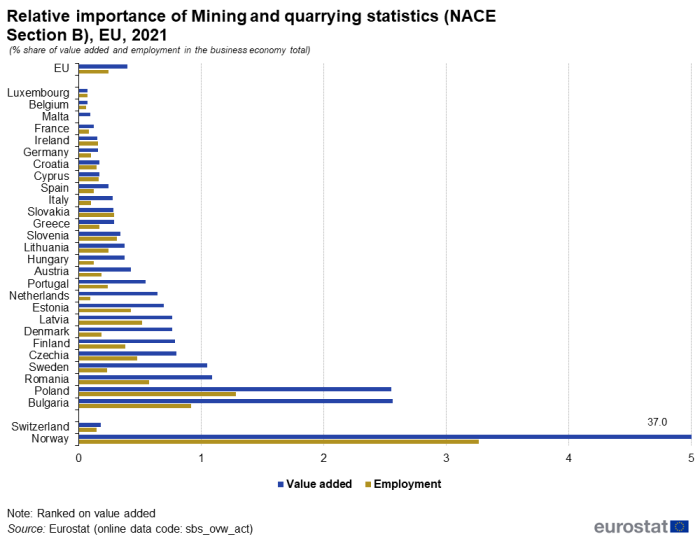
(% share of value added and employment in the business economy total)
Source: Eurostat (sbs_ovw_act)
Poland recorded the highest share (22.2 %) of EU value added within the mining and quarrying sector in 2021. The Netherlands was also a relatively large producer within the EU in value added terms (14.0 %), followed by Germany, Sweden and Italy. The Polish mining and quarrying employment of 146 000 persons was equivalent to more than one third (38.6 %) of the EU total, and was followed by Germany (10.1 %), Romania (7.1 %) and Czechia and Bulgaria (each 5.2 %). The five largest Member States in the mining and quarrying sector accounted for a share of EU value added that was lower than the business economy as a whole, while in terms of employment it was higher than the business economy as a whole (see Figure 3).

(cumulative share of the five principal Member States as a % of the EU total)
Source: Eurostat (sbs_ovw_act)
The relative significance of the mining and quarrying sector across the EU Member States tended to be highest among those countries specialised in the extraction of fossil fuels: these figures were closely linked to the geological distribution of fossil fuel deposits, which were scarce or non-existent in many of the Member States. Bulgaria recorded the highest ratio in mining of metal ores, while Poland was the most specialised in mining of coal and lignite and Latvia in other mining and quarrying.
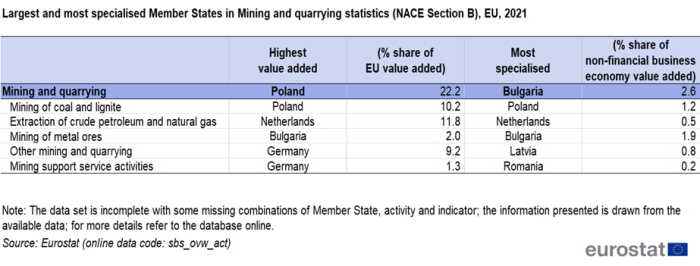
Source: Eurostat (sbs_ovw_act)Table 3:
Among the EU Member States, the highest apparent labour productivity in mining and quarrying in 2021 was recorded in the Netherlands, where this measure reached €677 600 per person employed. It was followed by Sweden, with €423 100 and Denmark, with €366 700 per person employed. Norway had higher apparent labour productivity than any Member State (€1 649 100). Denmark recorded the highest level of average employee benefits expense within the mining and quarrying sector in 2021, €121 900 per employee, above the EU average of €39 100 per employee. On the other hand, average employee benefits expense was below €20 000 per employee in Croatia, Bulgaria, Latvia, Lithuania and Hungary. Combining these two indicators gives the wage-adjusted labour productivity ratio, which is a measure of labour productivity that takes into account the very different levels of pay and social charges between Member States and activities. The highest such ratios were recorded in the Netherlands (647.8 %), Sweden (518.0 %) and Hungary (479.1 %). The lowest wage-adjusted labour productivity ratios in manufacturing were registered in Greece (112.7 %), Slovenia (123.3 %) and Slovakia(133.2 %).

Source: Eurostat (sbs_ovw_act)
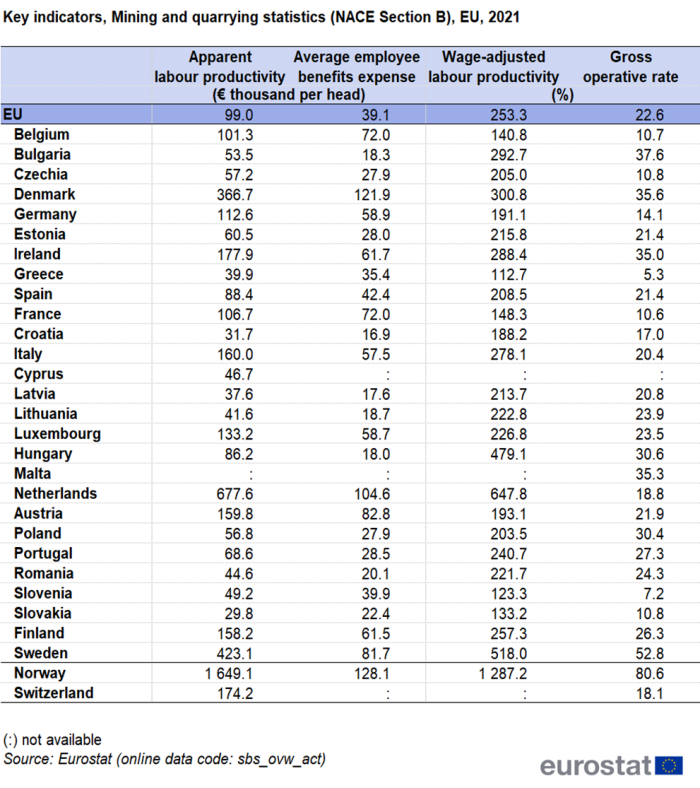
Source: Eurostat (sbs_ovw_act)
Data sources and availability
Coverage
Mining and quarrying, covers NACE Rev. 2 Section B. This activity concerns the extraction of:
- fossil fuels such as coal (Division 05), crude petroleum and natural gas (Division 06);
- ferrous and non-ferrous metal ores (Division 07);
- construction materials (for example, stone and sand) and other industrial materials such as salt, phosphates and gemstones (Division 08);
- it also includes mining support service activities (Division 09).
Note that this article only covers extractive activities, and not the downstream processing of fuel, nor the manufacture of non-metallic mineral products, both of which are classified under manufacturing (Section C), nor the network supply of energy (Section D) (Section D).
Data sources
The analysis presented in this article is based on the main dataset for structural business statistics (SBS), size class data and regional data, all of which are published annually.
The main series provides information for each EU Member State as well as a number of non-member countries at a detailed level according to the activity classification NACE. Data are available for a wide range of variables. Structural business statistics cover the 'business economy', which includes industry, construction and many services (NACE Rev. 2 sections B to N, P to R as well as division S95 and S96). Structural business statistics do not cover agriculture, forestry and fishing, nor public administration. Structural business statistics describe the business economy through the observation of units engaged in an economic activity; the unit in structural business statistics is generally the enterprise. An enterprise carries out one or more activities, at one or more locations, and it may comprise one or more legal units. Enterprises that are active in more than one economic activity (plus the value added and turnover they generate, the people they employ, and so on) are classified under the NACE heading corresponding to their principal activity; this is normally the one which generates the largest amount of value added.
In structural business statistics, size classes are generally defined by the number of persons employed. A limited set of the standard structural business statistics variables (for example, the number of enterprises, turnover, persons employed and value added) are analysed by size class, mostly down to the three-digit (group) level of NACE. The main size classes used in this article for presenting the results are:
- small and medium-sized enterprises (SMEs): with 1 to 249 persons employed, further divided into:
- micro enterprises: with less than 10 persons employed;
- small enterprises: with 10 to 49 persons employed;
- medium-sized enterprises: with 50 to 249 persons employed;
- large enterprises: with 250 or more persons employed.
Structural business statistics also include regional data. Regional SBS data are available at NUTS levels 1 and 2 for most of the EU Member States, Iceland and Norway, mostly down to the two-digit (division) level of NACE. Regional data for Croatia was not available for 2012. The main variable analysed in this article is the number of persons employed. The type of statistical unit used for regional SBS data is normally the local unit, which is an enterprise or part of an enterprise situated in a geographically identified place. Local units are classified into sectors (by NACE) normally according to their own main activity, but in some EU Member States the activity code is assigned on the basis of the principal activity of the enterprise to which the local unit belongs. The main SBS data series are presented at national level only, and for this national data the statistical unit is the enterprise. It is possible for the principal activity of a local unit to differ from that of the enterprise to which it belongs. Hence, national SBS data from the main series are not necessarily directly comparable with national aggregates compiled from regional SBS.
Context
The location of mining and quarrying generally reflects the spatial distribution of mineral deposits. However, there can be considerable cost differences between mines, for example, in relation to the depth at which deposits are found, or whether they are on land or at sea. Aside from geographical and geological cost differences, the decision of whether or not to (re-)open a mine may also depend, among others, on global, commodity prices, employment practices, as well as regulations concerning the environmental impact of mining or the disposal of its waste. Opencast (or surface) mines and quarries are generally cheaper than deep mines — although they may be rejected in the planning stage due to their effect on local landscapes. All forms of mining and quarrying incur environmental costs, which may relate to the disposal of waste, increased pollution, potential for ground subsidence, or changes to the local supply and quality of water.
The mining and quarrying sector is characterised as a capital-intensive activity. This is particularly the case for projects that require exploration and test drilling in advance of the considerable investment required to establish a new mine or off-shore drilling facility. As such, the global mining and quarrying sector is characterised by a relatively small number of international enterprise groups that operate across the continents — some with extraction and/or support service operations in the EU. These large-scale producers are particularly common in the extraction of fossil fuels. The vast majority of hard coal and lignite that is extracted or imported into the EU is consumed as a transformation input, mostly used in conventional thermal power stations or in coke oven plants. Over several decades the EU’s coal mining activity has been in decline due to competition from coal imports and the substitution of other fuels to produce electricity, the latter stimulated in part by efforts to reduce emissions. Crude oil is essentially a transformation input, used in refineries.
Many of the products resulting from the activity of this sector are traded globally and prices are established on global markets. One of the most closely followed prices is the price of crude oil, which is not only of interest for this sector itself, but also for the many downstream activities that are intensive users of energy as well as the chemicals sector that uses petroleum as a raw material.
The extraction of construction materials is dominated by a large number of smaller enterprises, typically serving a local market in low-value, widely-available products. Whilst the EU is largely self-sufficient in the extraction of construction materials, there are a large number of other minerals that are essential for downstream manufacturing activities for which there is no indigenous supply within the EU; for example the EU has high net imports of metallic minerals. Other industrial minerals are often further processed in downstream industrial sectors, for example, in the manufacture of glass, concrete and basic or agricultural chemicals. Minerals are also used in industrial processes and precious and semi-precious stones and metals are used in jewellery and for some industrial processes.
Policies related to energy and to climate change are particularly important for many parts of the mining and quarrying sector. The EU aims to become a low-carbon, energy-efficient economy in the coming decades. The integrated energy and climate change policy laid out in December 2008 aimed to cut greenhouse gases by 20 %, reduce energy consumption by 20 % through increased energy efficiency and to meet 20 % of the EU’s energy needs from renewable sources by 2021 — these goals had implications on the way extractive activities operate. In a Communication in November 2010 the European Commission presented its Energy 2021 strategy for competitive, sustainable and secure energy — see also an article on the electricity, gas, steam and air conditioning supply sector.
Direct access to
Publications
- Recent Eurostat publications on SBS
- Key figures on Europe – 2023 edition – see subchapter on Business
- Eurostat’s Regional Yearbook – see chapter 8. Business
- News Release SBS – 2021 final data
Glossary
ESMS metadata files
- Structural business statistics – SBS metadata file
External links
- Environment, see: